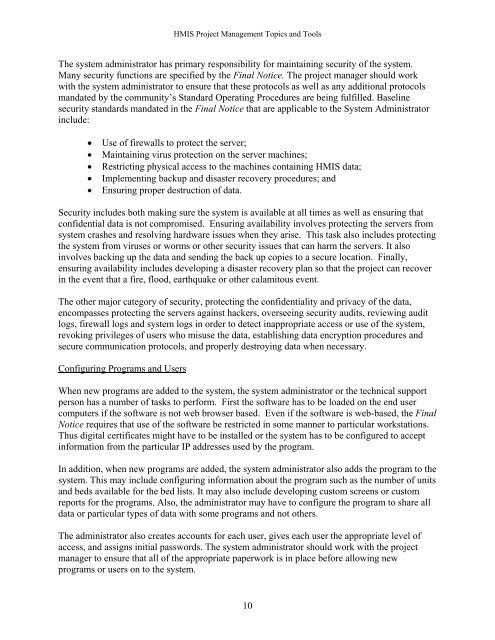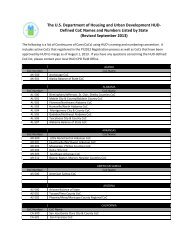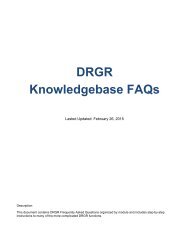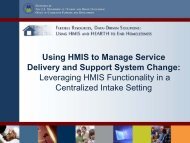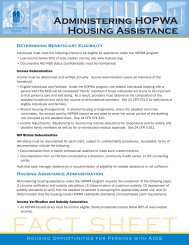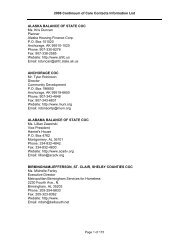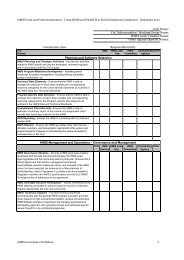HMIS Project Management Topics and Tools - OneCPD
HMIS Project Management Topics and Tools - OneCPD
HMIS Project Management Topics and Tools - OneCPD
- No tags were found...
You also want an ePaper? Increase the reach of your titles
YUMPU automatically turns print PDFs into web optimized ePapers that Google loves.
<strong>HMIS</strong> <strong>Project</strong> <strong>Management</strong> <strong>Topics</strong> <strong>and</strong> <strong>Tools</strong>The system administrator has primary responsibility for maintaining security of the system.Many security functions are specified by the Final Notice. The project manager should workwith the system administrator to ensure that these protocols as well as any additional protocolsm<strong>and</strong>ated by the community’s St<strong>and</strong>ard Operating Procedures are being fulfilled. Baselinesecurity st<strong>and</strong>ards m<strong>and</strong>ated in the Final Notice that are applicable to the System Administratorinclude:• Use of firewalls to protect the server;• Maintaining virus protection on the server machines;• Restricting physical access to the machines containing <strong>HMIS</strong> data;• Implementing backup <strong>and</strong> disaster recovery procedures; <strong>and</strong>• Ensuring proper destruction of data.Security includes both making sure the system is available at all times as well as ensuring thatconfidential data is not compromised. Ensuring availability involves protecting the servers fromsystem crashes <strong>and</strong> resolving hardware issues when they arise. This task also includes protectingthe system from viruses or worms or other security issues that can harm the servers. It alsoinvolves backing up the data <strong>and</strong> sending the back up copies to a secure location. Finally,ensuring availability includes developing a disaster recovery plan so that the project can recoverin the event that a fire, flood, earthquake or other calamitous event.The other major category of security, protecting the confidentiality <strong>and</strong> privacy of the data,encompasses protecting the servers against hackers, overseeing security audits, reviewing auditlogs, firewall logs <strong>and</strong> system logs in order to detect inappropriate access or use of the system,revoking privileges of users who misuse the data, establishing data encryption procedures <strong>and</strong>secure communication protocols, <strong>and</strong> properly destroying data when necessary.Configuring Programs <strong>and</strong> UsersWhen new programs are added to the system, the system administrator or the technical supportperson has a number of tasks to perform. First the software has to be loaded on the end usercomputers if the software is not web browser based. Even if the software is web-based, the FinalNotice requires that use of the software be restricted in some manner to particular workstations.Thus digital certificates might have to be installed or the system has to be configured to acceptinformation from the particular IP addresses used by the program.In addition, when new programs are added, the system administrator also adds the program to thesystem. This may include configuring information about the program such as the number of units<strong>and</strong> beds available for the bed lists. It may also include developing custom screens or customreports for the programs. Also, the administrator may have to configure the program to share alldata or particular types of data with some programs <strong>and</strong> not others.The administrator also creates accounts for each user, gives each user the appropriate level ofaccess, <strong>and</strong> assigns initial passwords. The system administrator should work with the projectmanager to ensure that all of the appropriate paperwork is in place before allowing newprograms or users on to the system.10


